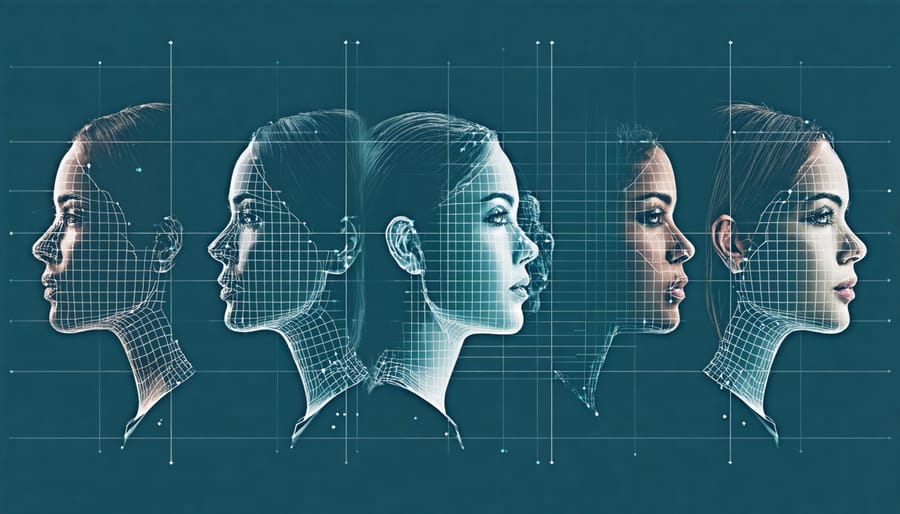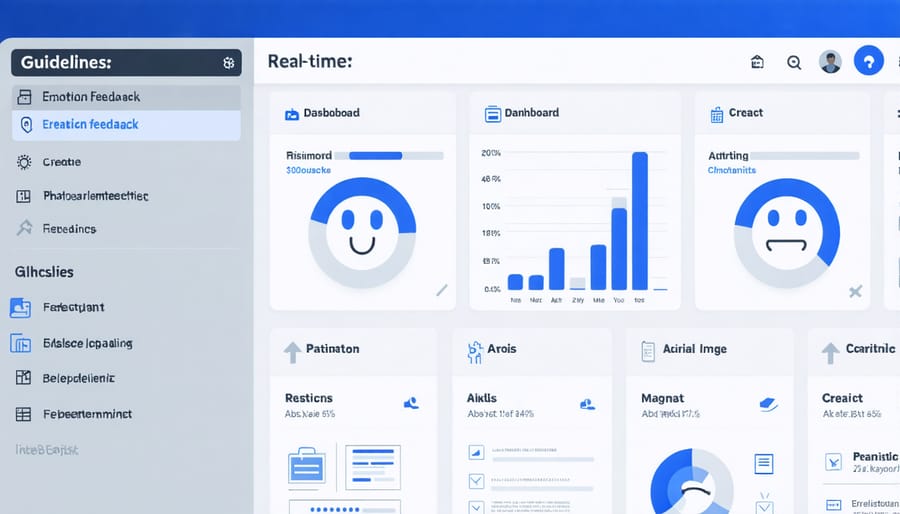Imagine a world where your smartphone can detect your frustration before you slam it down, or your car can sense your drowsiness before you drift off. This isn’t science fiction – it’s the rapidly evolving field of AI emotion recognition, where machines are learning to read human feelings with remarkable accuracy.
Today’s AI systems can analyze facial expressions, voice patterns, body language, and even physiological signals to understand human emotions in real-time. This technology is transforming everything from mental health support to customer service, creating more empathetic and responsive digital experiences.
As artificial intelligence becomes more sophisticated in detecting subtle emotional cues, it’s opening new frontiers in human-computer interaction. Companies are already implementing these systems to gauge customer satisfaction, enhance virtual assistants, and improve safety in vehicles through driver monitoring.
Yet this powerful capability raises important questions about privacy, consent, and the authenticity of human emotional expression. As we stand at the intersection of AI advancement and human psychology, understanding both the potential and limitations of emotion recognition technology becomes crucial for developers, businesses, and users alike.
The Science Behind AI Emotion Recognition
Key Technologies and Methods
AI emotion recognition relies on three primary technologies working in concert to create human-like AI interactions. Facial recognition technology uses computer vision to analyze facial expressions, mapping key points on the face to identify micro-expressions and emotional states. This process involves detecting features like raised eyebrows, smile lines, and eye movements to interpret emotions with increasing accuracy.
Voice analysis, the second key component, examines various aspects of speech, including tone, pitch, rhythm, and speaking rate. By analyzing these vocal characteristics, AI systems can detect emotional undertones such as excitement, stress, or hesitation that might not be apparent in the words alone.
The third pillar, behavioral pattern detection, tracks user actions, gestures, and interaction patterns. This might include analyzing typing speed, mouse movements, or touch screen interactions on mobile devices. These behavioral markers, when combined with facial and voice data, create a comprehensive emotional profile of the user.
Modern systems integrate these technologies using machine learning algorithms that continuously improve their accuracy through real-world interactions and feedback loops.

Machine Learning Models in Emotion Detection
Machine learning models form the backbone of modern emotion recognition systems, with several algorithms excelling in different aspects of emotional analysis. Convolutional Neural Networks (CNNs) have proven particularly effective in facial emotion recognition, processing visual data through multiple layers to identify facial features and expressions with remarkable accuracy.
Support Vector Machines (SVMs) continue to be valuable for their ability to classify emotions based on facial landmarks and vocal parameters, especially in situations with limited training data. Deep Learning architectures, particularly Recurrent Neural Networks (RNNs) and Long Short-Term Memory (LSTM) networks, excel at analyzing sequential data like speech patterns and temporal emotional changes.
Recent advances have introduced transformer-based models, which have revolutionized emotion detection in text and speech. These models can understand context and nuances in communication, leading to more accurate emotion classification. Ensemble methods, combining multiple algorithms, have shown promising results by leveraging the strengths of different approaches.
Transfer learning has emerged as a powerful technique, allowing models trained on large datasets to be fine-tuned for specific emotion recognition tasks, making implementation more accessible for organizations with limited resources.
Implementing Emotion Recognition in UX Design
Real-time User Response Analysis
Real-time emotion recognition systems offer invaluable insights into user experience by providing immediate feedback on how users interact with products, services, or content. As users engage with an interface, AI algorithms analyze facial expressions, voice patterns, and other behavioral cues to gauge emotional responses in the moment, creating a dynamic understanding of user sentiment.
This immediate analysis enables businesses and developers to identify pain points and moments of delight instantly. For example, when a user encounters a frustrating website feature, the system can detect their negative emotional response through micro-expressions and behavioral changes. This real-time feedback allows for swift adjustments and personalized responses to improve the user experience on the fly.
The technology also excels in adaptive learning environments, where content difficulty or presentation style can be adjusted based on a student’s emotional state. If the system detects confusion or frustration, it can automatically provide additional explanations or simplify the material to maintain engagement and optimize learning outcomes.
In customer service applications, real-time emotion recognition helps virtual assistants and chatbots adjust their communication style and responses based on the user’s emotional state. This creates more empathetic and effective interactions, leading to higher customer satisfaction and resolution rates.
Moreover, these systems can aggregate emotional response data across multiple users, providing valuable insights for continuous improvement and optimization of user experiences. This data-driven approach helps organizations make informed decisions about design changes and feature implementations based on actual user emotional responses rather than assumptions.

Adaptive Interface Design
Modern emotion recognition systems are revolutionizing user interface design by creating dynamic, responsive experiences that adapt to users’ emotional states in real-time. These intelligent systems work by analyzing facial expressions, voice patterns, and physiological signals to understand how users feel while interacting with applications or websites.
When a user shows signs of frustration, for instance, the interface might automatically simplify its layout or offer additional help options. Conversely, if a user appears engaged and confident, the system could present more advanced features or complex interactions. This approach to AI-powered accessible design ensures that each user receives a personalized experience tailored to their emotional needs.
Popular implementations include color scheme adjustments based on stress levels, font size modifications for better readability when fatigue is detected, and the introduction of breaks or calming elements when anxiety signals are identified. E-learning platforms have been particularly successful with this technology, adjusting lesson difficulty and presentation style based on students’ emotional responses.
These adaptive interfaces are also proving valuable in healthcare applications, where they can modify information presentation based on a patient’s emotional state, making complex medical information more digestible and less overwhelming. As the technology continues to evolve, we’re seeing more sophisticated responses to subtle emotional cues, creating truly empathetic digital experiences.
Personalization Through Emotional Data
Emotional data has revolutionized the way companies create personalized digital experiences for their users. By analyzing facial expressions, voice patterns, and other emotional indicators, AI systems can adapt content, interfaces, and recommendations in real-time to match users’ emotional states.
For example, streaming services can adjust their content suggestions based on viewers’ emotional responses to different shows or movies. If a user shows positive emotional engagement with romantic comedies, the system might prioritize similar feel-good content. Similarly, educational platforms can modify lesson difficulty or presentation style when detecting frustration or confusion in students.
Gaming companies are particularly adept at using emotional data for personalization. Modern games can adjust difficulty levels, background music, or even narrative elements based on players’ emotional reactions. This creates a more immersive and enjoyable gaming experience that responds to each player’s unique emotional journey.
In customer service, chatbots and virtual assistants use emotion recognition to tailor their responses and communication style. When detecting anxiety or frustration, they might adopt a more empathetic tone or quickly escalate issues to human agents. This emotional awareness helps create more natural and satisfying interactions.
The key to successful emotional personalization lies in striking the right balance between responsiveness and subtlety, ensuring that adaptations feel natural rather than intrusive.
Ethical Considerations and Privacy

User Consent and Data Protection
When implementing AI emotion recognition systems, protecting user privacy and obtaining proper consent are paramount. Organizations must establish clear protocols for collecting and storing emotional data, ensuring transparency about how this sensitive information will be used.
Best practices include implementing a comprehensive consent management system that clearly explains what emotional data is being collected, how it’s processed, and who has access to it. Users should have the option to opt-out at any time, and their data should be automatically deleted upon request.
Organizations should adopt a privacy-by-design approach, incorporating data protection measures from the initial stages of system development. This includes data minimization principles, collecting only essential emotional data needed for the intended purpose, and implementing robust encryption methods for data storage and transmission.
Regular privacy impact assessments help identify potential risks and vulnerabilities in emotion recognition systems. Organizations should also maintain detailed documentation of their data handling practices and regularly update their privacy policies to reflect any changes in data collection methods or usage.
It’s crucial to consider cultural differences and sensitivities when collecting emotional data. Different cultures may have varying comfort levels with emotional expression and monitoring, requiring flexible consent mechanisms that respect these differences.
Training staff on data protection protocols and establishing clear incident response procedures ensures responsible handling of emotional data throughout its lifecycle. Regular audits of data collection practices help maintain compliance with evolving privacy regulations and industry standards.
Bias and Accuracy Challenges
Despite significant advances in AI emotion recognition technology, several crucial challenges remain regarding bias and accuracy. One of the most pressing issues is the cultural bias inherent in many datasets used to train these systems. Emotional expressions can vary significantly across different cultures, yet many AI models are primarily trained on data from Western populations, leading to less accurate recognition of emotions in other cultural contexts.
Facial recognition systems often struggle with accurate emotion detection across different skin tones, ages, and genders. Studies have shown that these systems typically perform better on lighter skin tones and male faces, highlighting the need for more diverse and representative training data.
Environmental factors also impact accuracy. Variables such as lighting conditions, camera angles, and image quality can significantly affect the system’s ability to correctly interpret emotional expressions. Additionally, human emotions are complex and often mixed, making it challenging for AI to categorize them into distinct categories accurately.
Context plays a crucial role in emotion interpretation, yet many AI systems analyze expressions in isolation. For instance, a smile might indicate happiness in one context but discomfort in another. Current AI systems struggle to incorporate these contextual nuances, potentially leading to misinterpretation.
To address these challenges, developers are working on more inclusive datasets and sophisticated algorithms that consider cultural and contextual factors. Regular bias testing and continuous model refinement are becoming standard practices in the development of emotion recognition systems.
Future Trends and Opportunities
The landscape of AI emotion recognition is rapidly evolving, promising exciting developments in the coming years. As machine learning algorithms become more sophisticated and datasets grow larger, we can expect significantly improved accuracy in detecting subtle emotional nuances. One of the most promising trends is the integration of multimodal analysis, combining facial expressions, voice patterns, and physiological signals for more precise emotional assessment.
The healthcare sector is poised to benefit tremendously from these advances, with AI systems capable of early detection of mental health conditions through emotional pattern analysis. Smart hospitals may soon implement emotion recognition systems to monitor patient well-being and adjust care protocols in real-time. In education, adaptive learning platforms will leverage this technology to gauge student engagement and emotional states, customizing content delivery for optimal learning outcomes.
The retail industry is exploring innovative applications where AI-driven personalization combines with emotion recognition to create highly responsive shopping experiences. Smart mirrors in fitting rooms might adjust lighting and music based on customer emotions, while virtual shopping assistants could adapt their communication style to match the shopper’s emotional state.
Emerging opportunities also exist in remote work technologies, where emotion recognition could help bridge the empathy gap in virtual meetings by providing subtle emotional cues to participants. The automotive industry is investigating systems that monitor driver emotional states to enhance safety and comfort, potentially integrating with autonomous driving systems.
As edge computing capabilities advance, we can expect more real-time emotion recognition applications on mobile devices, enabling more personalized and emotionally aware apps. The integration of this technology with augmented reality (AR) and virtual reality (VR) experiences will create new possibilities for immersive entertainment and therapeutic applications.
However, these developments will need to navigate evolving privacy regulations and ethical considerations, likely leading to innovative solutions that balance technological capability with user privacy and consent.
As we’ve explored throughout this article, AI emotion recognition represents a powerful tool for enhancing user experiences when implemented thoughtfully and ethically. For UX designers looking to incorporate this technology into their work, several key considerations emerge.
First, remember that emotion recognition should complement, not replace, traditional UX research methods. Use it as part of a holistic approach to understanding user needs and behaviors. Start small by implementing basic emotion tracking in user testing sessions before scaling to larger applications.
When designing emotion-aware interfaces, prioritize transparency and user consent. Clearly communicate how and when emotional data is being collected, and provide users with easy opt-out options. This builds trust and addresses privacy concerns while maintaining the effectiveness of your emotional recognition systems.
Consider creating adaptive interfaces that respond subtly to emotional cues rather than making dramatic changes. For example, adjust color schemes or messaging tone based on detected stress levels, but avoid overwhelming users with constant interface modifications.
Looking ahead, stay informed about emerging technologies and evolving ethical guidelines in the field. As emotion recognition becomes more sophisticated, opportunities for creating more empathetic and responsive designs will continue to grow.
Remember that successful implementation requires cross-functional collaboration between UX designers, developers, and ethics specialists. By working together and keeping user needs at the forefront, we can harness the potential of AI emotion recognition to create more meaningful and engaging digital experiences.

